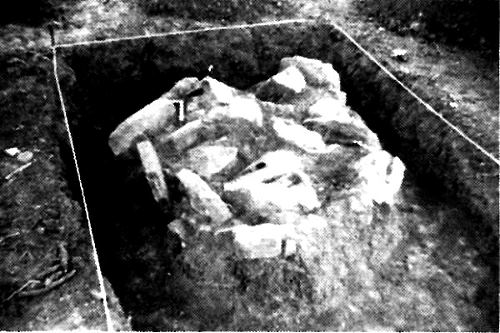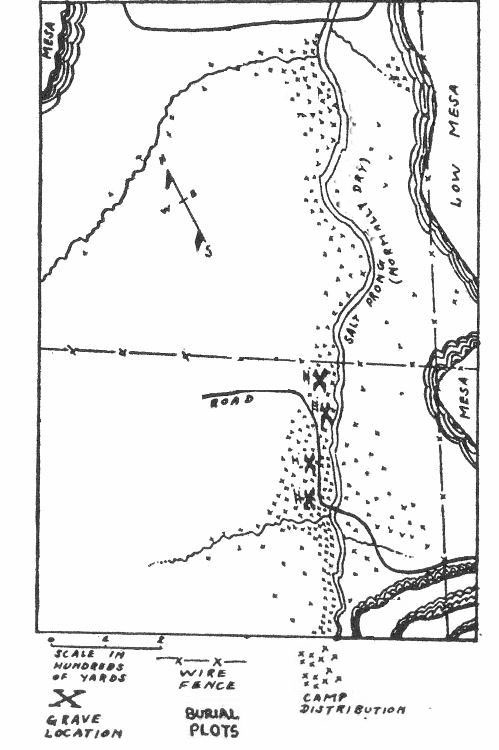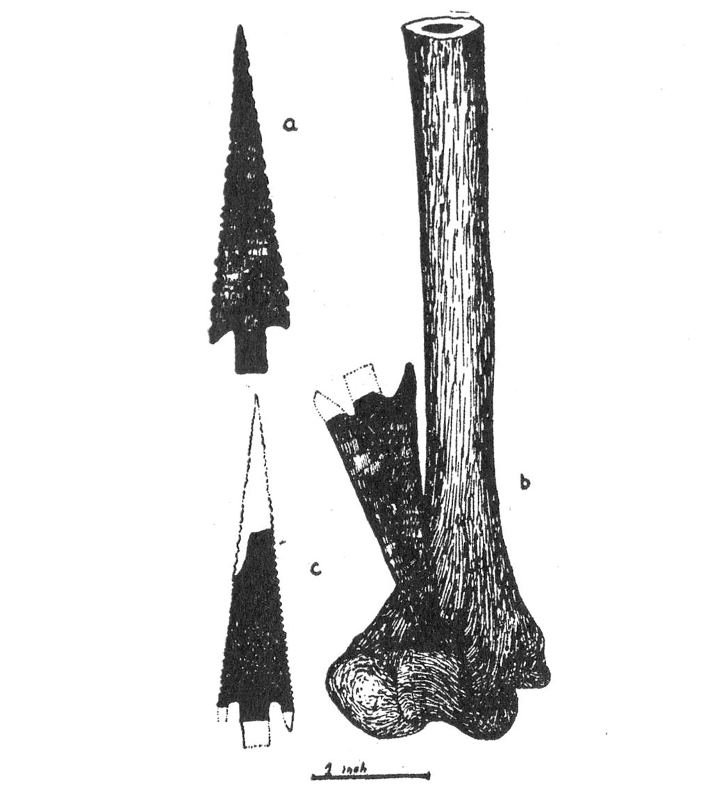Site 41SF18 |
An oval �fence� of flat rocks surrounds one of the four burial "plots" at 41SF18. This plot contained the burials of eight individuals: two adult females, one adult male, two infants, and a child. Adapted from drawing by Robert Forrester (1951: Fig. 5D ). |
This Shackleford County site containing 18 burials is one of the largest and most significant cairn burial sites investigated in the region, containing evidence of violent death and the “signature” of the perpetrator: a Moran-type arrow point still embedded in the bone of one of the individuals. The burials were found within four separate burial areas, or plots, within an extensive prehistoric campsite along a creek terrace. Covering an area roughly one mile long long by 300 yards wide, surface campsite remains included hearths and scatters of chipped-stone tools. Excavations were conducted in the late 1930s by avocational archeologist Robert Forrester, who reported his work in the 1951 TASP Bulletin. This article may be downloaded for more details of this work. The summary below includes illustrations from the article. Among the most significant findings were the remains of two young men who apparently died of arrow wounds. Their bodies had been placed in an unlined pit on a small rise and covered with a large flat stone, which was then capped with additional stones (Burial Plot II). Although both apparently were interred at the same time, their bodies were arranged in markedly different fashion. The first individual had been placed in semi-flexed position on his side, with forearms crossed and one of his hands at his chin. The charred mandible of a child lay in the chest region, perhaps having been worn as a grisly trophy of an enemy or relic of a loved one. A serrated arrow point was found above the top of the right femur (thigh bone), in a position suggesting he may have been shot in the back. The remains of the second young man were completely disarticulated and scattered over the first skeleton. A serrated projectile point was embedded in the right humerus (upper arm). Several elements were missing from these remains, including the hand and foot bones. The distal end of the right ulna (forearm) was broken and appeared to have cut marks on the outer side of the bone, suggesting the hand may have been taken as a war trophy. Another burial (Plot I), located roughly 150 feet northeast of Plot II, had been disturbed by a bulldozer clearing the field. One large flat stone and a pile of smaller rocks covered the remains of a ca. 35-year-old man, lying on his right side. Burial Plot III contained the remains of nine individuals, some of whom had been interred at different times. Two burials were of young men, one of whom lay directly underneath the flexed remains of an elderly woman. Under the skull of this man was a grave offering of bone tools: one deer antler tip, three split deer bones (radii), one unfinished awl, one polished deer radius awl, and a deer ulna flaking tool. The tool kit was in a compact mass, as if originally placed in a pouch. A broken stemmed projectile point also was found in this grave. Separated by a vertical stone-slab wall from the others was an adult male laid in flexed position, on his side. As in the burial of the other male, a grave offering had been place under his head; this consisted of two freshwater mussel shells, two deer ulna tools, and a charred, headless snake skeleton. Other burials in this plot included four infants and a young female. Surrounded by an oval stone “fence,” Burial Plot IV held the remains of six individuals. Among these was a child found with two incised bone tubes. Forrester suggested these may have been bone handles, perhaps for a carrying basket. An adult female was interred nearby, her burial intruding into the grave of the child. She was in tightly flexed position in the center of the plot. Slightly over a yard from her burial was an adult male, found with a notched and incised marine shell pendant. On the same level, a young female also had been buried with a shell gorget made of freshwater mussel. Two infants, placed in flexed positions, had been interred on the chest and pelvis of the man. This cemetery population is remarkable for the number of infants and the presence of an elderly woman (age estimated at around 70). All of the skulls of the adults were considered to be doliocephalic (long-headed), which seems to be fairly typical of remains within cairn burials in this region. A number of unusual offerings were placed in graves at this cemetery. The presence of Moran type serrated arrow points places at least some of these burials within the Blow Out Mountain phase in Late Prehistoric I times. |
|




